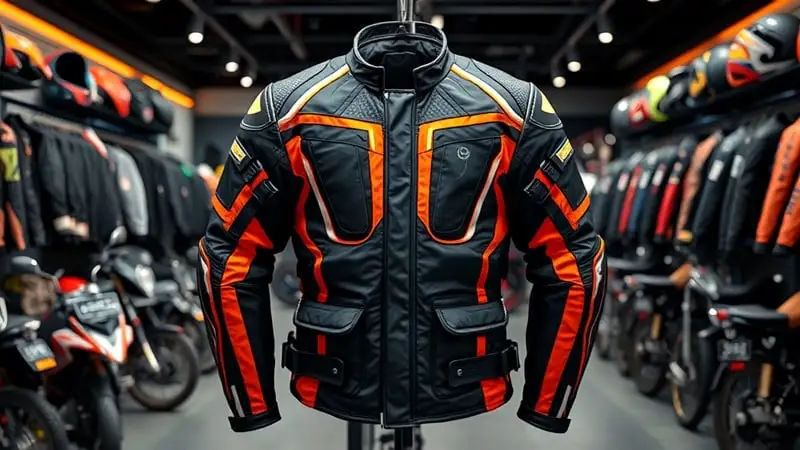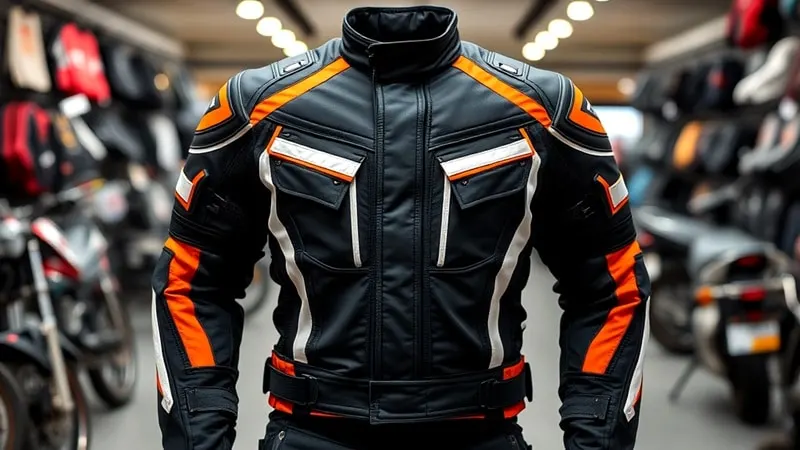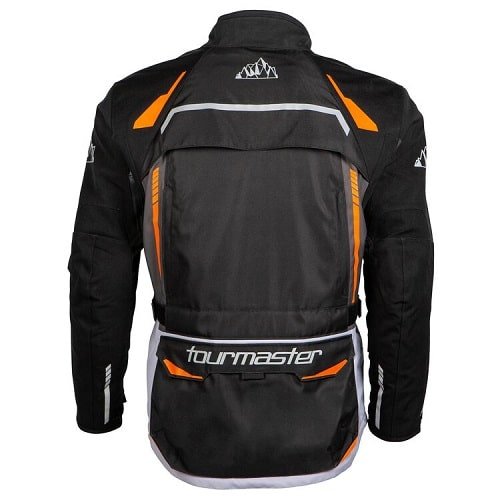Riding in the rain can be an exhilarating experience. The roads are emptier, the temperatures cooler, and there’s a certain thrill to powering through poor conditions. But it could be more fun if your gear leaves you cold, wet, and uncomfortable.
That’s why investing in a quality waterproof jacket should be a top priority for any motorcyclist who doesn’t park the bike when dark clouds loom.
But does that mean you need to spend a small fortune on touring-level waterproof gear? Not necessarily.
However, the main question I will answer in this review is: Is this the best waterproof motorcycle jacket for you? Let’s find out!
Tourmaster Highlander

Our Tourmaster Highlander Final Verdict
After spending considerable time with the Tourmaster Highlander, I’m impressed by its versatility and value.
I’ve worn it on long highway rides, city commutes, and weekend jaunts through twisty backroads. The jacket’s robust construction and thoughtful design have consistently exceeded my expectations.
I really like how the Highlander balances protection with comfort. The CE-approved armor in the shoulders and elbows provides reassuring impact protection without feeling bulky or restrictive. The abrasion-resistant outer shell gives me confidence in its ability to hold up in a slide.
The ventilation system is a standout feature for me. On hot days, I can open the chest, back, and arm vents to create a refreshing airflow.
It’s not quite as breezy as a mesh jacket, but it’s more than adequate for most summer riding.
In my experience, the weather protection is solid. The waterproof liner has kept me dry through unexpected showers, and with the thermal liner installed, I’ve stayed warm on chilly morning rides. The ability to remove both liners makes it adaptable to a wide range of conditions.
Potential Drawbacks to Consider
After testing the Highlander extensively, I’ve noticed a few potential downsides:
- The armor, while effective, isn’t the most advanced on the market. Riders looking for top-tier impact protection might want to consider upgrading.
- Some taller riders report that the sleeve length is a bit short, which could be an issue for those with longer arms.
- The waterproof liner, while effective, can feel a bit clammy in humid conditions.
- At higher speeds, the vents can create some wind noise, which might be bothersome on long highway rides.
Despite these minor drawbacks, I find the Tourmaster Highlander to be an excellent all-around jacket, especially considering its price point.
It’s worth noting that prices can change as special offers become available from Revzilla.com, so I’d recommend checking out their best prices before buying elsewhere. Our data shows that Revzilla won’t be beaten on price, thanks to their price match guarantee.
If you found this review helpful, please like and share the article. It helps Google know you like the page and allows more riders to discover this information.
Comparison To Similar Models
| Model | Features |
|---|---|
| Tourmaster Mariner | – 600D polyester construction – Waterproof and breathable membrane – CE Level 1 armor in shoulders and elbows – Removable thermal liner |
| Alpinestars Stratos V2 Techshell | – Techshell fabric with Drystar waterproof membrane – CE Level 1 Bio-Lite shoulder and elbow protectors – Removable thermal liner – Multiple ventilation zippers |
| Belstaff Ariel 2 Pro | – Wax cotton and tech wax construction – Waterproof and breathable membrane – D3O armor in shoulders and elbows – Classic styling with modern protection |
| REV’IT! Torque 2 H2O | – Polyester 600D construction – Hydratex waterproof liner – CE Level 1 SEEFLEX armor in shoulders and elbows – Detachable thermal liner |
Comparison:
- The Tourmaster Mariner offers good value with its waterproof features and CE armor at the lowest price point.
- The Alpinestars Stratos V2 provides advanced ventilation options, making it suitable for varied weather conditions.
- The Belstaff Ariel 2 Pro stands out with its premium materials and classic styling but at a significantly higher price.
- The REV’IT! Torque 2 H2O balances features and price, offering a good mid-range option with its Hydratex liner and SEEFLEX armor.
Tour Master’s new Highlander jacket and pants aim to deliver premium protection and features without the premium price tag.
The Highlander combo provides ample venting, removable insulation, and waterproofing comparable to gear costing twice as much.
Construction and Materials

Both the jacket and pants utilize a durable 500-denier nylon shell, with 1,000 denier abrasion panels in high-wear zones.
The elbows, shoulders, knees, seat, and crotch panels use Cordura fabric for added abrasion resistance. The shell incorporates a waterproof yet breathable laminate layer to keep moisture out while allowing sweat vapor to escape.
Zippers and Fasteners
The main zipper is a heavy-duty YKK model. It’s built to last and won’t let you down mid-ride. The cuffs and waist have adjustable straps with hook-and-loop closures, letting you fine-tune the fit.
Drawbacks
I have noticed that it can feel a bit stiff when new. It needs some breaking in. Also, some taller riders found the sleeves a tad short.
Cut and Comfort

The American cut provides a relaxed fit with extra room through the chest and stomach. For my 5’10” frame, the medium size includes sufficient adjustability to cinch the waist snugly while allowing a jacket liner or mid-layer underneath.
The pants in size 32 fit my slim build well, though the thighs and rear have extra room to accommodate layering. Those seeking a trimmer fit may want to size down.
Both the jacket and pants include removable 75g insulation liners. The quilted material isn’t overly bulky yet adds noticeable warmth, extending comfort into the 50s with just a t-shirt underneath. Separating the shell and insulation gives you modular versatility.
The liner attaches with a full-length zipper and includes two stash pockets. The pant liner is secured with sturdy snap buttons. Wearing both simultaneously couples the waterproof jacket and pants while providing insulation for cool weather riding.
Ventilation

I’ve put the Tourmaster Highlander’s ventilation system through its paces, and I’ve got to say, it’s pretty impressive. Here’s what I found:
Vent Placement
It has strategically placed vents on the chest, back, and arms. This setup creates a nice airflow that keeps you cool when the mercury rises. I’ve found the chest vents especially effective – they’re like having a personal AC unit on your bike.
Weather Protection
I’ve put the Tourmaster Highlander through its paces in various weather conditions, and here’s what I’ve found:
Waterproofing
The water-repellent coating on the outer shell that works well in light rain. It’ll keep you dry during short showers or misty conditions.
For heavier downpours, there’s a removable waterproof liner. I’ve ridden through some serious storms, and I’ve stayed bone-dry underneath. The liner does its job well, but it can be a bit of a hassle to put in and take out.
Cold Weather Performance
When the temperature drops, this model really shines. The thermal liner is thick and cozy – it’s like wearing your favorite sweater under your gear.
I’ve ridden in temperatures near freezing, and with a good base layer, I’ve stayed toasty warm. The collar’s high and snug, which keeps cold air from sneaking down your neck.
Wind Protection
The Highlander’s a champ at blocking wind. Even at highway speeds, I don’t feel any cold air seeping through. The adjustable cuffs and waist help seal out drafts, which makes a big difference on chilly days.
Hot Weather Adaptability
In warmer weather, you can remove both liners for better airflow. The vents do a decent job, but on really hot days, you might still feel a bit warm. It’s not a jacket I’d choose for mid-summer desert riding.
Versatility
What I love about this jacket is how it handles temperature changes. On long rides where the weather can shift, I can easily adjust by adding or removing layers. It’s like having multiple jackets in one.
Drawbacks
While out on a hot day, I found that the arm vents can be a bit tricky to open while riding. At high speeds, the vents can create a bit of wind noise.
Also, the waterproof liner can be a bit clammy in humid conditions. Also, some found that it takes a while to dry out after heavy rain exposure.
The Tourmaster Highlander’s weather protection is solid overall. It’s not the most high-tech jacket on the market, but it’ll keep you comfortable in most conditions you’ll encounter on the road.
Whether you’re battling a thunderstorm or cruising through a chilly mountain pass, it has your back.
Armor and Safety

I’ve taken a close look at the Tourmaster Highlander’s armor and impact protection features. Here’s what I found:
Included Armor
It comes with CE-approved armor on the shoulders and elbows. This armor is designed to absorb and distribute impact forces in a crash.
It’s not top-of-the-line stuff, but it’ll do the job in most situations. The armor’s flexible, so it moves with you and doesn’t feel like you’re wearing a suit of medieval plate mail.
Additional Protection
There’s a pocket for a back protector, but you’ll need to buy that separately. I’d recommend doing so – it’s a small investment for a big safety boost.
The jacket also has reinforced seams in high-impact areas. This extra stitching helps keep it from splitting open if you slide down the road.
Safety Standards
The armor meets European Union safety standards, specifically the EN 1621-1:2012 certification. This means it’s been tested to reduce impact forces below a certain threshold. It’s not the highest level of protection out there, but it’s a solid baseline.
Crash Performance
I haven’t crashed in this jacket (thankfully), but I know people who have, and they have reported that it holds up well in minor spills. The outer shell resists abrasion decently, though it’s not as tough as some high-end adventure jackets.
One rider mentioned that in a low-side crash at about 40 mph, it protected them from road rash, but the impact was still felt through the armor. Another noted that the elbow armor shifted slightly in a fall but still provided protection.
Drawbacks
I have noticed that the elbow armor sits too high on their arms. This could leave your elbows exposed in a crash. If you’re on the tall side, you might want to try one on and check the armor placement before buying.
The Tourmaster Highlander’s armor and impact protection are solid for its price point. It’s not the most advanced system out there, but it’ll keep you safer than riding without protection. Just remember, no gear is crash-proof – ride smart and stay alert out there.
Storage and Convenience

Ample storage options provide sufficient cargo capacity. It houses two waterproof exterior pockets, two hand pockets with waterproof zippers, an interior stash pocket, and a rear compartment.
The pants include two waterproof hip pockets along with a water-resistant thigh stash pocket.
The collar is secured with both a button and an adjustable hook-and-loop strap. Coupled with a soft fleece lining, this prevents water intrusion while eliminating throat chafing and flap vibration.
The pants come equipped with full-length side zippers for easy on/off over boots. Hook-and-loop ankle cinches allow tightening over shoes or tucking into boots.
Interior Lining
I’ve taken a close look at the Tourmaster Highlander’s interior lining, and I’m impressed with its design and functionality. Here’s what I found:
Thermal Layer
It comes with a removable thermal liner. It’s quilted and feels cozy against the skin. I’ve worn it on chilly morning rides, and it does a great job of trapping heat. The best part? I can easily zip it out when the temperature rises.
Moisture-Wicking Properties
The main interior lining is made of a moisture-wicking material. It’s not some fancy brand-name fabric, but it works. On longer rides, I’ve noticed it pulls sweat away from my body, keeping me dry and comfortable.
Comfort Features
There’s a soft neoprene collar lining that feels great against my neck. No chafing, even on all-day rides. The cuffs have a similar soft lining, which is a nice touch when you’re wearing short gloves.
Waterproof Membrane
Bonded to the main lining is a waterproof, breathable membrane. It’s not removable, which some riders might see as a drawback. But I’ve found it keeps me dry without making me feel like I’m wearing a plastic bag.
Drawbacks
The thermal liner can bunch up a bit when you’re putting it on. It’s not a deal-breaker, but it can be annoying.
The Tourmaster Highlander’s interior lining system is well-thought-out. It’s not the most high-tech setup I’ve seen, but it does the job well.
Whether you’re battling the cold on an early spring ride or dealing with summer showers, this lining system’s got you covered.
It’s a solid balance of comfort and functionality that’ll keep you riding in a wide range of conditions.
Real-World Performance
I wore the jacket and pants on a one-hour ride during steady rainfall to test waterproofness. The shell fabric beaded water effectively, and I stayed completely dry underneath.
In warm weather, opening the plentiful vents provides adequate cooling while moving. At stoplights, things heat up quickly, but airflow resumes once back in motion.
The generous fit accommodates winter layering well. When temperatures drop, the insulated liners add noticeable warmth and wind resistance.
Comfort-wise, the fleeced lining across the collar and inner wrists prevents chafing. The pants ride comfortably without digging into the knees when seated.
After hundreds of miles of wear, neither the jacket nor the pants show any signs of leaking or premature wear. Overall, the construction appears durable.
Pros & Con’s
Pros
- Durable 500D shell with abrasion-resistant panels
- Waterproof and breathable laminate layer
- Removable quilted insulation liners
- Relaxed American cut with adjustment straps
- Abundant ventilation options
- CE armor in shoulders, elbows, and knees
- Multiple storage pockets
- Reflective accents for visibility
Cons
- Hip pads not CE-rated
- Thighs and rear have a roomy fit
- Jacket back armor not included
Previous Article: Revit Mile Review
Next Article: Cortech Hyper-Tec Review

